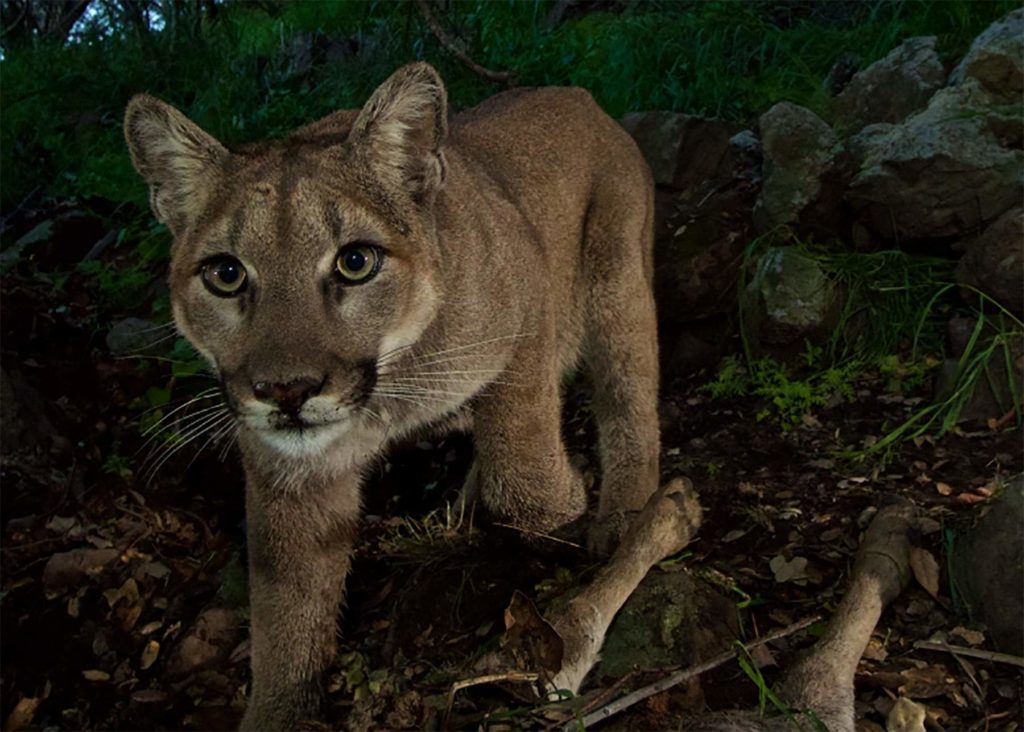Mountain Lions Can Rebuild Nation

AS WE SIFT THROUGH THE RUBBLE of a four-year blitzkrieg on the country’s air, water, wildlife and climate, we’re heartened to see the Biden administration articulating bold ideas about repairing the wreckage. Most impressive is his commitment to protecting 30 percent of the Earth’s landscape in nature reserves by the year 2030. In this spirit of building back better, we suggest adding one overlooked keystone to America’s reconstruction — mountain lions.
America’s reigning big cat, the mountain lion could start reviving ailing forests, slowing runaway climate change, saving lives — and maybe even restoring our faith in humankind. All for little more than us allowing the cat home, after driving them from half the country.
Once a commanding presence from coast to coast, America’s lion (aka cougar, puma, panther, catamount) was swept from the eastern forests on the European settlers’ tide of clearcuts, guns, traps, and puritanical fears of the unknown. While the cat has since reclaimed much of its native range in the West, there hasn’t been a confirmed birth of a wild lion east of the Mississippi in the last century, beyond one endangered population of panthers stranded in south Florida.
Missing Lions and Tattered Forests
THE LION’S BANISHMENT from the East has contributed to unprecedented herds of forest-stripping deer that have some ecologists fearing the deer more than climate change. Not to mention the 200 of us dying each year in deer-related car accidents.
Mountain lions could start curing those ills — restoring wildlife-harboring, carbon-storing , climate-saving forests — much as the cats and their fellow apex predators have demonstrated around the world. Scientists have been amassing a burgeoning body of evidence from big cats, wolves and great sharks, revealing their inordinate powers to grow healthier forest and range, sea grass and reef.
The East holds great swaths of deer-bitten forests just dying for lions, from the Great Okefenokee Swamp of Florida to the Great North Woods of Maine. New York’s Adirondack Park alone, at three times the size of Yellowstone, could support up to 350 mountain lions.
The East is lacking its lions, but not for their lack of trying. Over the last 30 years more than a hundred lone lions have been documented trekking eastward from their Rocky Mountain stronghold, crossing the Plains in search of mates. One of them made it to within 20 miles of Manhattan. All died without meeting a mate or leaving progeny.
That steady trickle of wanderlust lions from the West has been repeatedly met by a gauntlet of guns and speeding cars. On the plains of South Dakota, through which many of the eastward wanderers pass, citizens are welcomed to hunt them with dogs 365 days a year. Thus fall the East’s would-be pioneers across America’s self-described Heartland.
Even the endangered little enclave of federally protected lions that survives in the cypress swamps of south Florida is under attack. Most recently the political machinery of Florida has been pushing two new massive developments, a 45,000-acre residential complex and a major highway, driving two stakes through the heart of the Florida panther’s supposedly protected habitat. The federal plan for saving the panther prescribes expanding the current lone population of some 200 cats to three populations of 240 panthers each. That plan has been sitting on the shelves for 40 years.
Across the Great Divide
THE ANTI-CARNIVORE mantra used to justify such intolerance — that the beasts, if left unhunted, would slaughter all our livestock, shutter the deer-hunting industry, then start coming for our kids at the bus stop — is a toxic old canard thoroughly debunked by science and contradicted daily by the lions and people of California.
The only western state whose citizens have outlawed lion hunting, California remains one of the safest of states for its livestock, deer, and humans. Every year, Californians by the thousands gather to celebrate a mountain lion who has famously taken up residence in the middle of Los Angeles. California cat champions have also donated $18 million and counting toward construction of what’s slated to be the world’s largest wildlife crossing —an earthen overpass for cougars, spanning the ten lanes of L.A.’s notorious, cat-crushing 101 Freeway.
Welcoming America’s lion back home won’t halt the roads and development incessantly whittling away its wild places. On the other hand, making room for lions to roam by preserving corridors of wildness could offer lifelines to many other species otherwise stranded in hostile new environs by the changing climate.
But what lions could do for this country goes beyond curbing the deer plague, mending tattered forests, and mitigating climate chaos. In a time of billion-dollar walls and widening societal rifts, choosing to live with lions would be a defiant show of unity, a noble show of humanity — a way to begin rewilding ourselves on the way to rewilding the Earth.
This is not a moonshot. It is a movement we could start today with little more than a teaspoon of political spine and an eastbound truck full of lions from the West. It is a movement we could start by simply relaxing our trigger fingers, and opening our arms to those wildest of neighbors we so wrongly fear.
Will Stolzenburg is the author of “Where the Wild Things Were” and “Heart of a Lion.” Tom Butler, author of “Wildlands Philanthropy,” is senior fellow at Northeast Wilderness Trust.